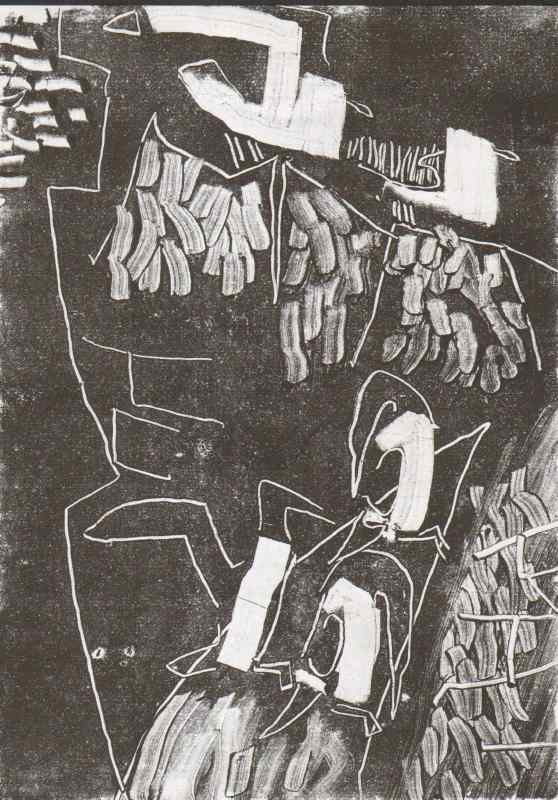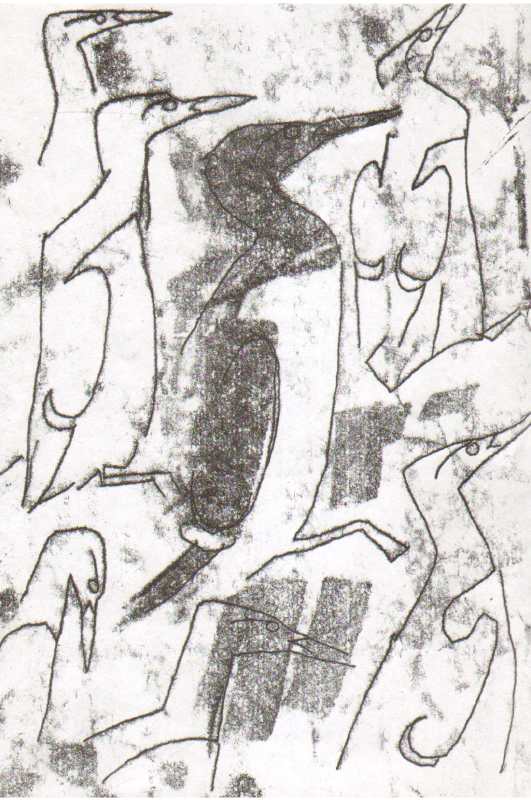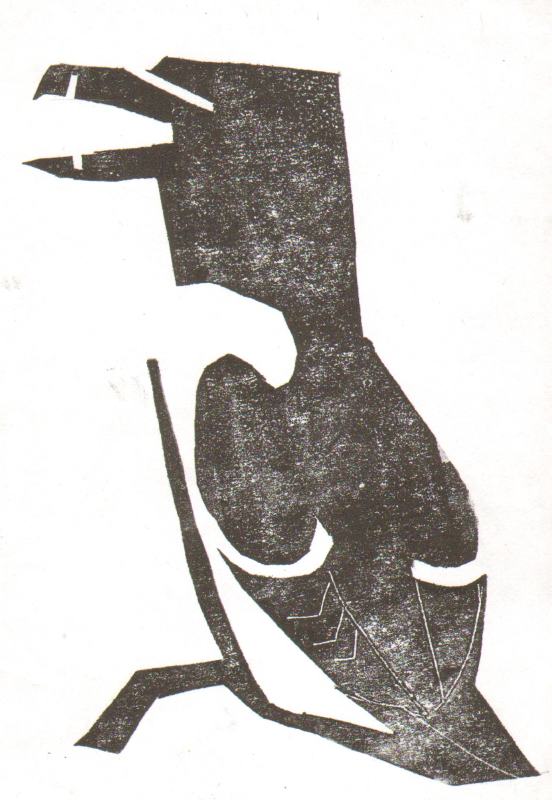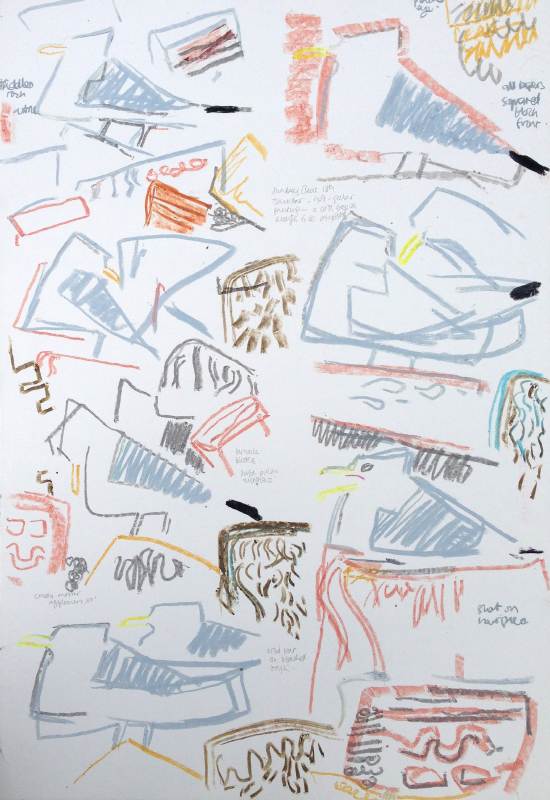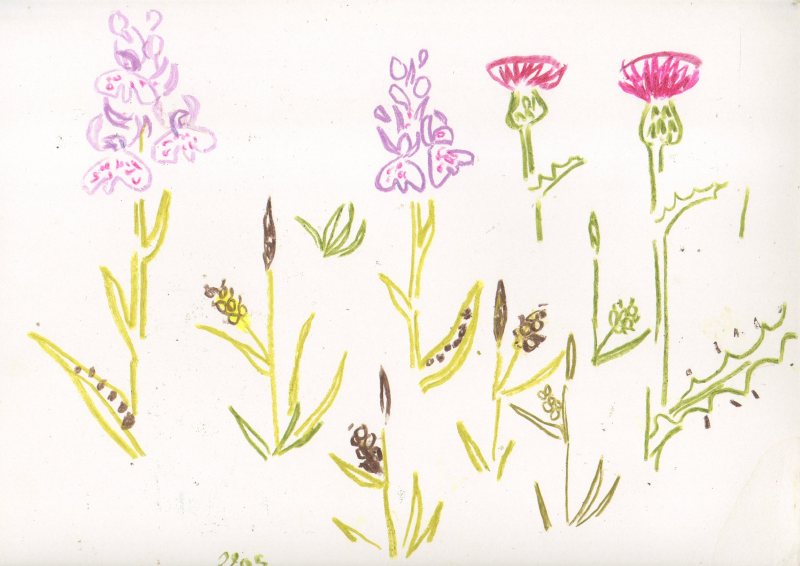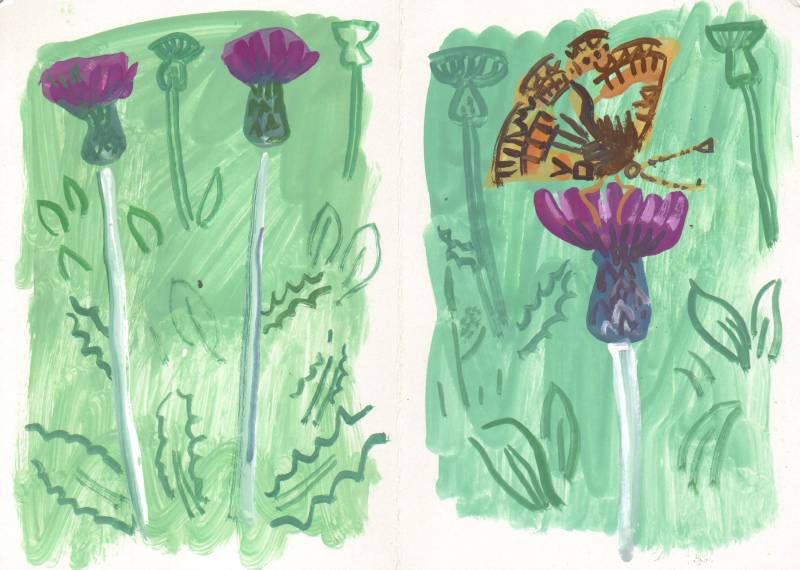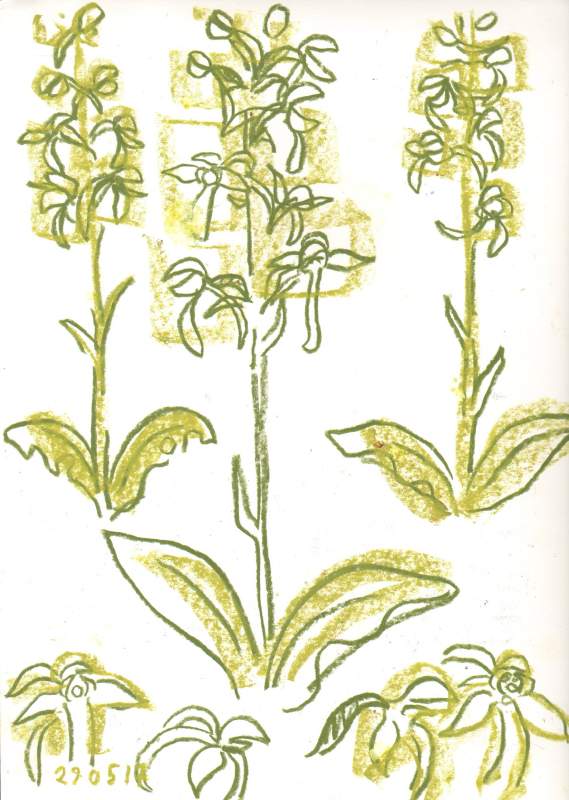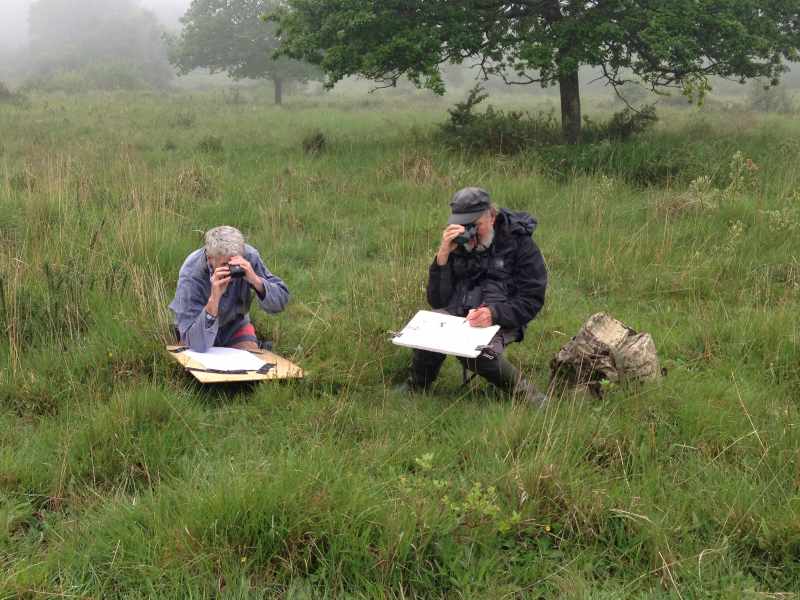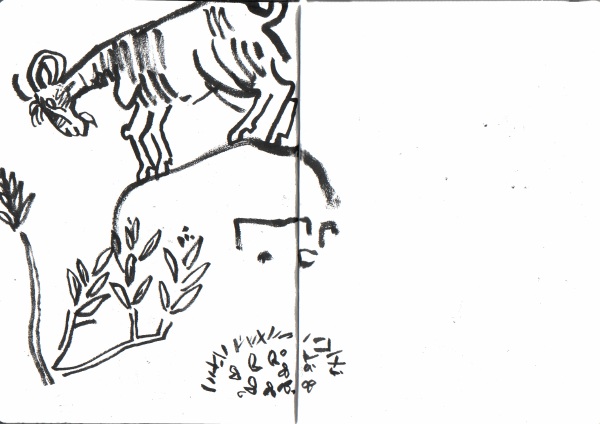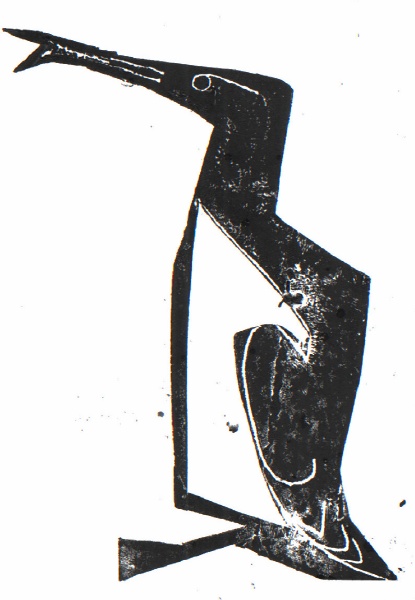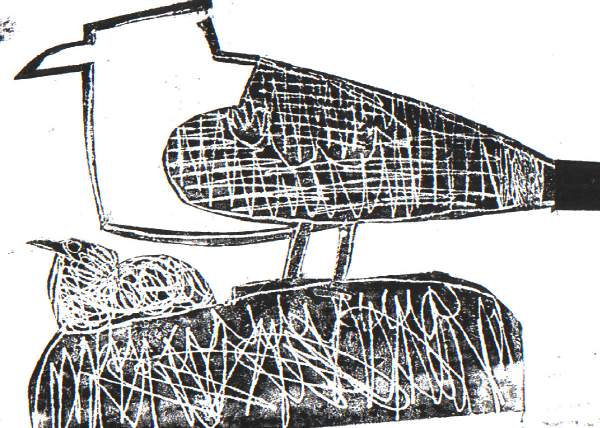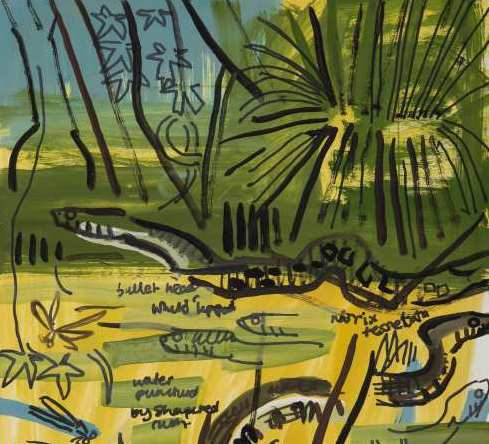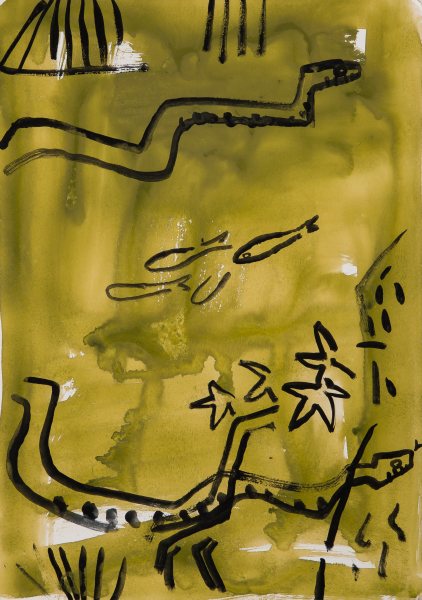The first time I’ve tried monoprinting in the field. Rolling up a perspex block with relief ink (rolled out on a separate ‘reservoir block’). Then scraping/incising into the surface with dowel for lines and metal scrapers made from mount cutter blades and bits of old visa cards. On some I started to work back positively with brush drawing.
I briefly tried the more schoolroom approach of hinging the printing paper onto the inked block and drawing on the back.
and made one card print cut directly using scissors to see how that felt.
There was something about the first approach that was telling me new things… able to carve out blocks of space very quickly … or carve out the breasts of the guillemots to hang linear drawing on. Something different to drawing with a dark line on a white page.
We tend to start the drawing course at Dunbar harbour as a way of easing into the week. The wall of kittiwakes is challenging but the nature of the space allows us to go round the group for the first time and have a chat with everybody about how their work is going.
Vehicles are within easy reach so people can adjust their field sketching kit if needs be.
I’d been using wax crayon on the Kingcombe project, mainly for flora and insects… somehow feeling the need for something with more heft for the forms of birds against the monolithic rocks. So for most of rest of the week I swapped to field monoprinting.
Morning sketching on the allotment meadow taking advantage of a gap in the rain. One or two Burnet moths emerging, several caterpillars seen over the past few weeks, I’ve only spotted a single cocoon.

common carder bumble on clover , 6 spot burnet on plantain – allotment bristol – wax crayon – 29.7 x 42 cms (A3)
The meadow is giving huge pleasure now, I planted thyme into the large anthill next to the makeshift bench up there and now only the top is bare. Lots of bee activity.
On the oxeye daisies several beetle species including the 2 sketched here.
The Dorset Wildlife Trust @DorsetWildlife hosted around 10 Society of Wildlife Artists (SWLA) @swlanaturaleye members over the Whit bank holiday weekend.
Of our 4 day stay I spent the last couple of days at Powerstock common and it was rich for insects and birds and a lovely range of flora.
In the heathy open areas the air thick with mist, drizzle and heavy downpours but also the intoxicating songs of tree pipit, yellowhammer, whitethroat and willow warbler.
Patches of Heath spotted orchid alongside meadow thistles. Marsh fritillaries, just emerging seemed to like feeding on the thistles.
The railway cutting fantastically filled with all sorts. Butterfly orchid at the edge of scrubby woodland. Bee orchids just coming into flower. Lots of twayblade. A grizzled skipper. Slow worm and crested newt hiding under corrugated metal sheets. Frustratingly a lot of this was happening as the sun came out, just as it was time to leave
Long Mead – Kingcombe
a large patch of heath spotted orchids and nearby the dark spikes of marsh thistle.
Lady’s mead – Kingcombe… a long sloping meadow full of buttercups with flushes of ragged robin and marsh orchids. The latter seem like the glamorous protagonists with the million buttercups as supporting cast. There was a strange lack of insects considering the wealth of flowers and the season. I’d guess less than 10 bumblebees in a huge field. The damselfly (azure I think) was the only dragonfly I saw other than demoiselles down by the stream.
Great to have 4 days of solid sketching, there is always some kind of group momentum with these projects… spurring each other on.
My brother visiting from Japan and we made a trip down to the increasingly mediterranean seeming somerset levels. 3 species of egrets, hobbies, harriers. On the ground a slow worm and a glow worm (larva).
on the canal sides whitethroats singing with background of reed warblers, buntings and the hedges alive with garden warbler song. Cuckoo males heard but not seen.
HIghlights of trip to Crete were a day spent at Polyrinia in the sun soaking up spring flora. Sculptural torches of giant fennel against architecture of yellow phlomis and tree spurge. Bees collecting red pollen from asphodels. Purple of tragapogon closing up its flowers at midday. Vultures and a single lammergeir rising above the peaks mid morning.
Then on the Southwest coast migrants in coastal pines. Kind of scene I would have dreamt about when I was a kid… collared flycatcher, redstart, cuckoo, spotted flycatcher all feeding up on their northward journey. A purple heron creeping up the beach next to a herd of goats.

6734 – golden plover, skylarks, lapwing – wallasea island – monoprint – 38 x 27 cms – Probably the most simple way of monoprinting, hinging paper onto a perspex block that is covered with a thin layer of ink. You then draw on the back with a biro or just press with fingers. The area at the bottom is working back into the ink, scraping and then rollering the back of the paper
2nd trip to Wallasea to look at the development of the reserve (see write up from first trip), One of a series of visits by SWLA artists in collaboration with the RSPB.
I used the time to carry on with my outdoor printing experiments. Focusing more on monoprint this time. It seems a bit crazy rolling out ink, perched on a seawall but it does seem worth it. Forced to simplify in diverse ways…Forced to be much more conscious of what happens to the paper surface (the slightest touch on the back of the paper will leave marks). There is a sense of ‘making moves’, how could I make a block of ‘ploughed earth’… and then suddenly you have a whole block of ploughed earth equivalent to push against… By masking bits of the ‘ploughed of earth’ with ripped paper there is a bit of saved space for a skylark or plover.
Final morning spent with golden plover in a freshly ploughed field, a merlin putting them up a couple of times. Flickering gold uppers and shining white bellies, timidly circling. Unsure whether to land on the plough again or head out to the mudflats. Keeping company with wood pigeons, stock doves, lapwing and skylarks.
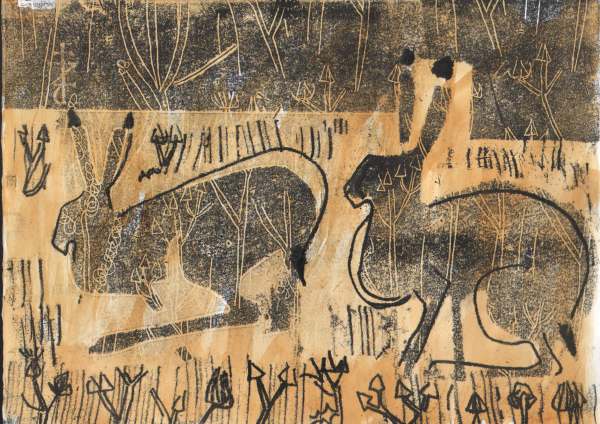
6741 – hares amongst arable weeds – wallasea island – monoprint – 21 x 29.7cms (A4) – using card incised wtih weed pattern to make tonal blocks, cutting stencils to block all but the hare forms, then drawing on the back of the paper for outlines.
The plant that seemed to predominate was bristly oxtongue, down in the huge fields below the newly raised sea defences some kind of tractor driven mower was gradually clearing swathes of it. Hares robbed of their cover were bounding around, seeming disorientated. I imagine that this was in preparation for ploughing that was already happening to the land off in the distance.
In general the scene was very quiet, few birds. Maybe partly because it will take a while for the new landscape to regenerate, also tides were quite low and so birds could stay down on the coastal margins.
Brin & Richard found a dead young brent goose on the sea wall, seemingly dying from exhaustion. It’s breast bone sharp with no fat either side. Hard to imagine that it had been an egg somewhere in Northern Russia only a few weeks ago.
Coming down to earth after what has seemed an epic field sketching month… 10 days based in Koycegiz, Western Turkey with Nik Pollard, Esther Tyson and Ben Woodhams. The project a DKM/SWLA collaboration. Working alongside some 20 or so Turkish degree/MA art students to interpret the threatened sweetgum forest. (I will write another post to try to describe this)….NB. all the artwork from the trip along with photos and videos is now on dogaicinsanat.wordpress.com
Then almost straight on to the Firth of Forth for the annual ‘John Busby seabird drawing course’. It was good to share the intensity of this with Ben who also came on the seabird course, felt like we were battle hardened veterans who’d braved the 40 degree heat in Turkey to be further tested by the wind and rain of the Scottish seabird cliffs.
A major feature of both of these was to be teaching whilst trying to push our own work. It is one of the great things about the seabird course that I think is quite rare… the tutors getting on with their own work alongside the ‘students’ … really nowhere to hide. So we all share what is inevitably something of an emotional roller coaster.
Tutors were Kittie Jones, John Threlfall and Darren Woodhead. Bruce Pearson joining us as a ‘visiting artist’ and Bruce also joined in the tutoring. I certainly feel I learn a lot from the ‘teaching’ and also from the other tutors.
I felt I made a couple of mini (or maybe even major breakthroughs)…John Threlfall led what seemed like an innocuous set of exercises on the 5th evening… blind contour drawing. So we looked at an object (eg a stuffed gannet) and then without looking at our paper traced round perceived contours… mentally connecting the end of our pencils with the contours of what we were looking at. We did this several times, changing perspective or subject and John was emphasising to do it very slowly. The pivotal point was when he asked us to turn our pencil round and use the non mark making end to carry on drawing… so blind and invisible marks. It somehow emphasised for me that this is what I’m doing when I’m looking for drawing… almost like the mind sending out hands to feel around the subject and it is those extended feelings that are going back down the arm onto the page…more or less successfully.
The next day we had to decide whether to hire a boat to go out round the Bass rock (& its 150,000 gannets). We knew we wouldn’t be able to land and it was set to be choppy with some people worried about sea sickness. In the end almost everyone came and it felt like it was a decisive point in the week for many… the frenzy of activity round the rock, the constant movement of the boat and the difficulties of handling drawing materials…. meant people just had to let go a bit. There was hardly any chatter and it felt like everyone was head down sketching for most of 2 hours.
For me there was some kind of connection with the previous evenings exercises and the scribbled bundles of lines that were making up the bodies of my sketched birds was different to what I would normally do… quickly getting down blocks of tone made of scrambled line… and felt like that had some of the springy energy of all the action and noise. I could then hang details of the birds off of the scramble. Something to build on.
The other breakthrough was following on from a mini printmaking session in Turkey. Nik had planned for all the students to make prints during a display in a public square in Koycegiz. Small postcard sized card prints… Lines incised with biro and blocks cut with scissors. Quick and relatively easy to make and when hung together looking good because of all being of the same medium and the same size.
I’d found it quite more’ish and played around a bit more on the hotel verandah before we left. I took bare essentials for repeating the exercise in Scotland as potential wet weather activity…. then got to think that I might be able to do it out on the cliffs.
I started out small with the A6 postcard size prints… filling frame with bird motifs and starting to play more with getting half tones by hatching.
On the final day at St Abbs it was a lot more challenging with wind and rain and moving up to A4 in scale… The shag at the top of page was probably as good as I got… the cleanness of the image not giving the sense of the mess I was in… paper and polythene flapping into wet ink…paper sodden, the ink becoming unusable in the rain, but then fine again once it had dried a bit. Final effort was starting to look at handling the bigger space. Definitely want to do more.
Towards the end of our time in Turkey we spent 2 sessions watching dice snakes on a river overhung by sweetgum. Turtles floating alongside them, shoals of small fish clearly visible in clear water and flourescent bright dragonflies in sparking light. I’ve never had a time where I could watch active snakes for prolonged periods. These were barely out of view for more than a few minutes at a time. We’d see them S’ing along the river edges, craning up to dangling vegetation and occasionally effortlessly transferring themselves up onto branches.
The only time we saw them catch something was when Nik and I were packing up and suddenly heard a plopping from a sedge clump right in front of us. First we saw one snake bracing itself amongst the sedges with a fish in its mouth, like a dog with a bone… then we realised there was another snake on the other end of the fish having a tug of war.
We never figured out what all the activity was about. Sometimes the snakes would drape themselves over the riverside branches, basking. Maybe it was mating season and they were in search of partners or maybe just hunting frogs. We were sure that we were seeing 5 or so, but with the frequency of sightings it was probably more.
My sister in law visiting from Japan came over from Wells on Sunday and brought presents including a couple of ready filled brush pens. Having a pre-loaded brush to hand quite more’ish.
A green woodpecker calling from the allotment (behind studio) had me poking my head over the back gate…made a good rest for binoculars and telescope. Getting a great look as it probed the banks that terrace the allotment beds. I’ve been trying to cultivate anthills on all our banks and mini meadow partly to lure the woodpeckers in. I’ve stuck thyme cuttings in lots of them… also some rock rose and birdsfoot trefoil. We’re lucky to have a south-east facing slope… perfect for the ants.
